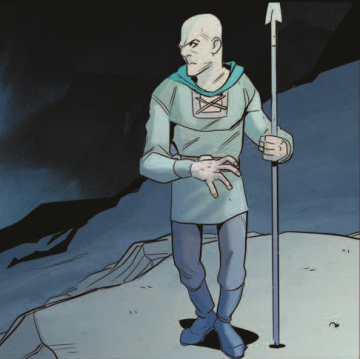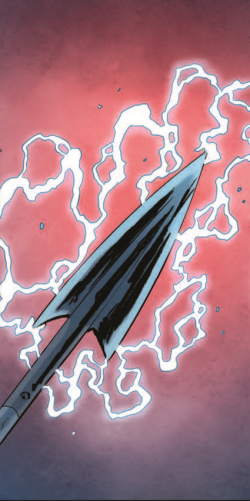Gungnir
Gungnir was a magic spear, also known as Hasta Fatum, the Odinspear, and the Lance of Fate. Following the destruction of the Three Keys to Power, it became one of the Three New Keys to Power.
History
Gungnir was used by Lord Valois to aid King Culen against Kenneth II in 971. Valois used Gungnir to conjure up watery hands to attack the Wyvern gargoyles, when they came to Kenneth II's aid in the battle with Culen. The Archmage counter-attacked with a spell, severing the spearhead from the shaft. ("The Draw")
At an unknown point in time, the lancehead became the prize of Anapaula Aguilar's husband's collection, despite unsuccessful attempts in acquiring the haft. By 1997, Doña Aguilar kept in her home in Buenos Aires, Argentina. When Dominique Destine paid the human (and her collection) a visit, she timed it to sunset so that she could transform into a gargoyle and steal the lancehead. ("Questions")
Promising him controlling interest to Nightstone Unlimited, Demona employed Thailog to steal the haft from the Illuminati's treasure on Eastcheap Isle. The gargoyle located it in Wyvern's horde while Shahrizad distracted the Society's Dragon Treasurer. ("Acquisitions")
Upon acquiring all Three Keys, Demona reassembled Gungnir in her townhouse and used its powers to target all humans on Earth. She managed to subjugate the humans in the boroughs of Manhattan and Brooklyn before she was cornered by Goliath, Angela, and Turquesa at LaGuardia Airport. Once she was separated from the three Keys, Coldfire directed the three of them to release the city's enthralled humans from Demona's geas. Once the spell was broken, Turquesa snapped the spear once more. It is unclear what became of the pieces. ("Unequivocal Success", "Queen of All She Surveys")
Characteristics
Gungnir is a spear of vast magical power that is said to be incapable of missing its target. Valois demonstrated this in 971 when he used it to cast spells on the Wyvern Clan and the armies of the Three Brothers. Upon uniting the Three New Keys to Power in 1997, Demona repaired the spear for the first time in over a millennium. Merely wearing the spear burned the gargoyle, but Demona considered the pain useful, keeping her focused in her task to target every human on Earth. ("The Draw", "Unequivocal Success")
Apocrypha
Upon hearing that Diablo had abducted Angela in order to bleed her and use her blood for his Elixir Vitae, Demona arrived to help save her daughter and defeated the alchemist with a lightning bolt fired from the spear's lancehead. ("Both Alike In Dignity...")
Real World Background
In Norse mythology, Gungnir was the spear of Odin. It was forged for him by a group of dwarves known as the Sons of Ivaldi (they were hired to do so by Loki; he had cut off the hair of Thor's wife Sif, and to stop an enraged Thor from beating him up, got the dwarves to make fresh hair for Sif – and, presumably to mollify the gods' wrath further, not only the spear Gungnir, but also a magic ship named Skidbladnir for the god Freyr). Like the lance in Gargoyles, Gungnir always hit its mark.
Richard Wagner included a version of this spear in his Ring of the Nibelung operatic cycle, though here unnamed. In Wagner's account, Wotan (his version of Odin) made the spear from a branch of the World Tree (Wagner's version of Yggdrasil), killing the tree in the process. He carved various runes on its shaft, to represent the laws he had sworn to uphold as the ruler of the gods. In the third opera in the cycle, Siegfried, the human warrior Siegfried breaks the spear in half battling Wotan, marking the end of Wotan's reign; Wotan takes the remains of the spear back to Valhalla, there to await his end and that of the gods.
"Hasta Fatum" is Latin for "Spear of Fate". ("Hasta" is a technical term for a kind of thrusting spear used in ancient Rome.)






